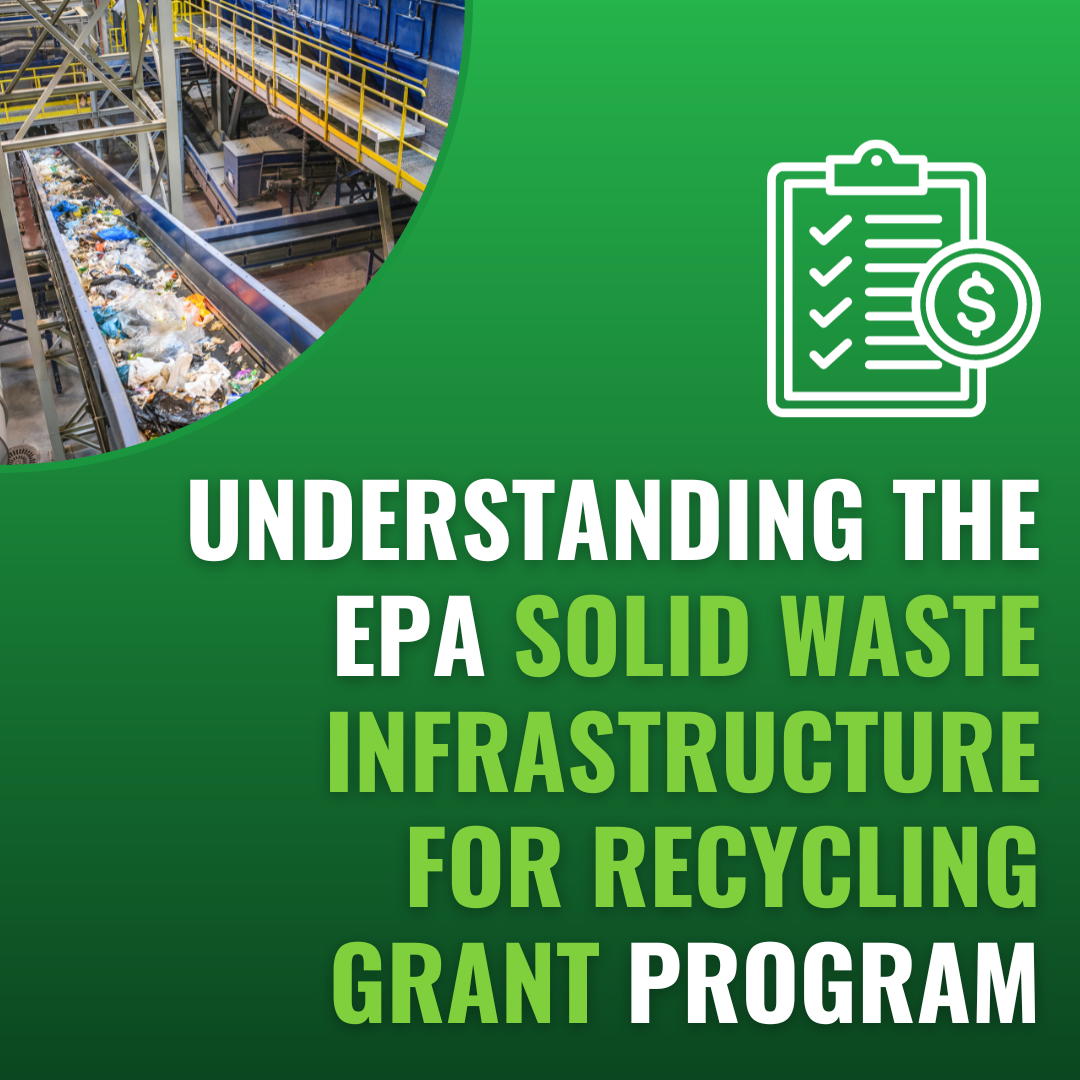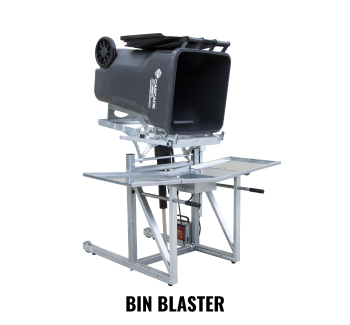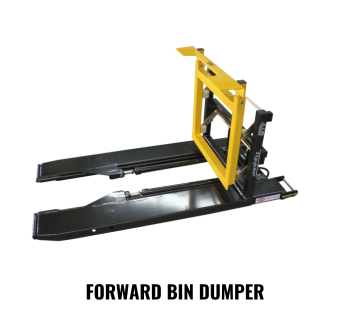We use cookies to make your experience better. To comply with the new e-Privacy directive, we need to ask for your consent to set the cookies. Learn more.
Understanding the EPA Solid Waste Infrastructure for Recycling Grant Program
In September 2023, the U.S. Environmental Protection Agency (EPA) announced the recipients of more than $100 million in grant funding for sustainable waste management projects. These recycling grants will help to build or improve waste infrastructure for municipalities, states, and territories.

The EPA’s September announcement covered two EPA grant programs: The Solid Waste Infrastructure for Recycling (SWIFR) Grants for Communities and the SWIFR Grants for States and Territories. Recipients of a third program — the SWIFR Grants for Tribes and Intertribal Consortia — were scheduled to be announced shortly after the EPA’s September release.
If you’re raising funds for recycling projects in your area, the bad news is that you’re too late for this particular round of funding. The good news is that this is just the first set of federal grant programs that can help improve your recycling infrastructure — and broader waste management systems, too.
Here’s what the recently completed Solid Waste Infrastructure for Recycling grant program can teach us about future EPA recycling grants. If you need to finance waste handling equipment, these facts might help give you the edge on a next round of federal funding for recycling infrastructure.
Explore waste handling solutions from Solus Group.
6 Takeaways From the 2023 EPA Recycling Grants
1. The Solid Waste Infrastructure grants of 2023 were funded through the Bipartisan Infrastructure Law of 2021.
The EPA’s 2023 SWIFR grant programs are the result of several federal projects, including laws, White House initiatives, and EPA strategies. The single largest contributing factor, however, was probably the Bipartisan Infrastructure Law of 2021.
That legislation set aside $275 million for grant programs. That’s the most money the U.S. has devoted to recycling investments in three decades.
In 2023, the $100 million worth of recycling grants were committed through two programs as follows:
- Around 25 communities received a total of over $73 million under the SWIFR Grants for Communities program.
- An additional $32 million or so was divided between the U.S.’ 56 states, territories, and the District of Columbia through the SWIFR Grants for States and Territories program.
The SWIFR Grants for States and Territories program was further justified by official EPA objectives, including the National Recycling Goal and the Food Loss and Waste Reduction Goal. Both sets of recycling grants also support the EPA’s overarching National Recycling Strategy.
2. The 2023 recycling grant programs were just the beginning of a five-year commitment to U.S. waste management and recycling infrastructure.
If you missed the 2023 recycling grant opportunity — or simply weren’t eligible for that year’s SWIFR funds — you may have more chances soon. The initial round of funding still leaves around $175 million to support solid waste management programs and infrastructure. 
The Bipartisan Infrastructure Law set aside that $275 million for EPA recycling grants with a strict schedule: The EPA would get $55 million per year from 2022 through 2026. Funds for 2022 and 2023 have already been committed, but later SWIFR grants (or similar programs) should become available in 2024, 2025, and 2026, too.
3. An additional law — the Save Our Seas 2.0 Act — places limits on the activities these recycling grants can fund.
The Bipartisan Infrastructure Law appropriated the funds for this set of EPA recycling grants. But an earlier law paved the way (and defined the limits) of these EPA grants.
The 2020 Save Our Seas 2.0 Act is meant to help clean up the oceans, particularly in regard to plastic pollution. Limiting future plastic waste is key to this effort, so the law called for a set of grant programs to support “post-consumer materials management infrastructure.”
Post-consumer materials include all the packaging and containers that remain when we’re done consuming a product. Sustainable management for these materials isn’t limited to recycling — there’s also reuse, composting, anaerobic digestion, and other strategies — but for plastics, recycling is often the most sustainable option.
At any rate, section 302 (a) of the Save our Seas 2.0 Act describes the limits of the EPA recycling grant programs we’re covering here. The law lists two sets of activities eligible for this grant funding:
- State activities that implement an EPA plan for sustainable post-consumer materials management, and;
- Improvements for local recycling programs and other sustainable waste management systems.
The SWIFR Grants for Communities program is authorized under the second requirement listed above. The SWIFR Grants for States and Territories is covered by the first. We can expect later rounds of EPA recycling grants to follow the same rules.
4. The 2023 SWIFR grants funded projects for 24 communities and 56 states or territories.
To understand who might be eligible for future SWIFR grants, it may help to look at the recipients of the first round of funding.
The EPA lists 24 recipients of SWIFR Grants for Communities, spanning all 10 EPA regions. Grant-winning projects included:
- Expanding residential recycling to all households in New Orleans, Louisiana. (Learn more about this project from the EPA.)
- Building new infrastructure for a food waste diversion program in Providence, Rhode Island. (Learn more.)
- Renovating a waste materials drop-off site in Durham County, North Carolina. (Learn more.)
Grant recipients for the SWIFR Grants for States and Territories, on the other hand, include the District of Columbia plus all 55 U.S. states and territories. Funds typically went to state or territory departments of environmental protection, natural resources, or other similar agencies.
While SWIFR Grants for Communities frequently went toward new waste handling equipment and facilities, the SWIFR Grants for States and Territories are only eligible to support state plans of post-consumer materials management. That may include writing new plans, updating old ones, collecting data, or implementation.
5. The SWIFR Grants for Communities’ two-track eligibility program may offer a hint about eligibility for future recycling grants.
These grants were designed to support a variety of related federal goals, strategies, and programs. The White House’s Justice40 Initiative played a particularly strong role in determining eligibility for the SWIFR Grants for Communities.
If this initiative continues, future rounds of funding could reflect some of the same eligibility requirements. To be specific, the SWIFR Grants for Communities program offered two eligibility tracks.
- The first track provided funds for projects that benefit disadvantaged communities, as defined by the Climate and Economic Justice Screening Tool’s methodology and other criteria (listed by the EPA here).
- The second track was for areas that don’t meet the criteria outlined in the previous bullet point.
The Justice40 Initiative seeks to devote 40 percent of federal investments to benefit disadvantaged communities, across a narrow range of categories related to environmental sustainability.
In line with this goal, the EPA said it would try to devote 40 percent of SWIFR funds to disadvantaged communities. The two-track eligibility framework helped the EPA meet this goal in its first round of SWIFR funding, and could continue in future recycling grant programs.
6. There’s a list of current and upcoming funding opportunities drawing on the Bipartisan Infrastructure Law’s funds for recycling grants.
The best way to see if you’re eligible for future recycling grants from the EPA is to apply — and to do that, you need to know when the EPA is accepting applications.
Luckily, the EPA keeps a frequently updated list of funding programs associated with the Bipartisan Infrastructure Law (and the related Inflation Reduction Act). Find that list of EPA grants here.
Ergonomic Waste Handling Equipment for Recycling Facilities
Material handling is at the core of any recycling program, so it makes sense that the first round of SWIFR Grants for Communities funding helped recipients buy waste handling equipment. Future rounds of funding are likely to support these purchases, too.
Improve safety and efficiency in your recycling facilities with ergonomic Bin Dumpers from Solus Group. These waste handling solutions lift and empty bins of virtually any size and shape. This reduces the risk of injury to workers while improving productivity in line with waste-diversion goals.
Solus Group offers a whole line of Bin Dumpers, plus accessories like Bin Dumper Chutes and Bin Dumper Cradles.
We also stock Forward Bin Dumper forklift attachments, Bin Blaster container-washing stations, and a range of bins and roll-out carts.
Your next EPA recycling grant can help fund these investments in Bin Dumpers and Bins. For help choosing the right waste handling equipment for your recycling facility, contact the Solus Group sales team at 314-696-0200 today.

